The global harsh environments fiber optic market is valued at USD 1,891.5 million in 2025 and is projected to reach USD 3,451.8 million by 2035, recording an absolute increase of USD 1,560.3 million over the forecast period. This translates into a total growth of 82.5%, with the market forecast to expand at a compound annual growth rate (CAGR) of 6.2% between 2025 and 2035. The overall market size is expected to grow by approximately 1.82X during the same period, supported by increasing demand for resilient communication infrastructure, growing adoption of fiber optic systems in extreme operating conditions across global industrial markets, and rising preference for high-performance optical solutions across oil and gas and geothermal applications.
The harsh environments fiber optic market represents a specialized segment of the global telecommunications infrastructure industry, characterized by advanced engineering requirements and increasing demand across industrial and energy sectors. Market dynamics are influenced by changing industrial digitization preferences, growing interest in remote monitoring technologies, and expanding partnerships between telecommunications companies and industrial equipment manufacturers in developed and emerging economies. Traditional communication infrastructure patterns are evolving as industries seek robust optical systems and advanced data transmission capabilities that offer enhanced reliability and seamless connectivity features in challenging operating conditions.
Consumer behavior in the harsh environments fiber optic market reflects broader trends toward resilient, high-performance communication systems that provide both operational efficiency and data transmission reliability benefits. The market benefits from the growing adoption of industrial automation, which is recognized for its advanced communication integration and digital-first approach to industrial operations. Additionally, the versatility of harsh environment fiber optic systems as both standalone communication solutions and integrated industrial monitoring platforms supports sustained demand across multiple industrial applications and operational environments.
Regional adoption patterns vary significantly, with North American and European markets showing strong preference for premium fiber optic implementations in extreme environments, while Asian markets demonstrate increasing adoption of cost-effective optical solutions alongside traditional industrial communication platforms. The industrial landscape continues to evolve with advanced and specialized fiber optic implementations gaining traction in mainstream industrial operations, reflecting industry willingness to invest in superior technology for perceived reliability improvements and connectivity features.
The competitive environment features established telecommunications equipment companies alongside emerging technology providers that focus on unique hardening capabilities and advanced environmental protection methods. Manufacturing efficiency and optical component optimization remain critical factors for market participants, particularly as material costs and environmental protection complexity continue to fluctuate. Distribution strategies increasingly emphasize multi-channel approaches that combine traditional industrial supply chains with direct partnerships through technology platforms and specialized engineering agreements.
Market consolidation trends indicate that larger industrial equipment manufacturers are acquiring fiber optic specialists to diversify their communication portfolios and access premium market segments. Private label development has gained momentum as industrial companies seek to differentiate their offerings while maintaining competitive pricing structures. The emergence of specialized harsh environment variants, including high-temperature resistant and chemically hardened options, reflects changing industrial priorities and creates new market opportunities for innovative optical component developers. Manufacturing automation and quality control improvements enable consistent fiber optic deployment scaling while maintaining traditional durability characteristics that industries expect from established telecommunications brands.
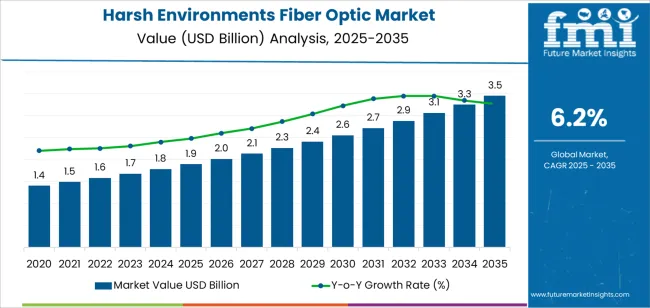
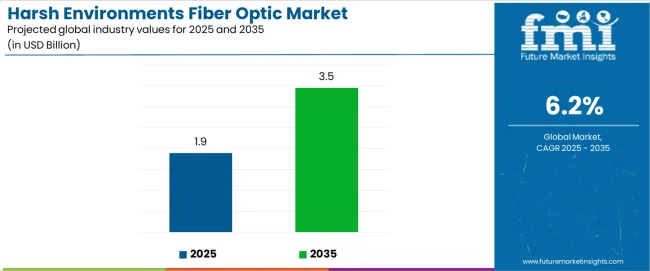
Between 2025 and 2030, the harsh environments fiber optic market is projected to expand from USD 1,891.5 million to USD 2,406 million, resulting in a value increase of USD 514.5 million, which represents 33% of the total forecast growth for the decade. This phase of development will be shaped by increasing adoption of industrial automation systems, rising demand for specialized and hardened solutions, and growing emphasis on advanced environmental protection features with enhanced durability characteristics. Industrial equipment manufacturers are expanding their fiber optic integration capabilities to address the growing demand for specialized harsh environment implementations, advanced customization options, and private label offerings across industrial segments.
| Metric | Value |
|---|---|
| Estimated Value (2025E) | USD 1,891.5 million |
| Forecast Value (2035F) | USD 3,451.8 million |
| Forecast CAGR (2025-2035) | 6.20% |
From 2030 to 2035, the market is forecast to grow from USD 2,406 million to USD 3,451.8 million, adding another USD 1,045.8 million, which constitutes 67% of the overall ten-year expansion. This period is expected to be characterized by the expansion of advanced optical systems, the integration of innovative environmental protection solutions, and the development of specialized fiber implementations with enhanced performance profiles and extended operational capabilities. The growing adoption of industrial IoT integration will drive demand for harsh environment fiber optics with superior data transmission characteristics and compatibility with automated monitoring technologies across industrial manufacturing operations.
Between 2020 and 2025, the harsh environments fiber optic market experienced steady growth, driven by increasing demand for resilient communication technologies and growing recognition of fiber optic systems as essential components for industrial operations across oil and gas and geothermal applications. The market developed as industrial manufacturers recognized the potential for fiber optic solutions to provide both communication functionality and operational monitoring benefits while enabling convenient data transmission protocols. Technological advancement in environmental hardening techniques and industrial-grade development began emphasizing the critical importance of maintaining system reliability and performance consistency in extreme operating environments.
Market expansion is being supported by the increasing global demand for resilient communication infrastructure and the corresponding need for hardened optical systems that can provide superior data transmission reliability and environmental protection benefits while enabling advanced industrial functionality and extended compatibility across various industrial and energy sector applications. Modern industrial operators and telecommunications specialists are increasingly focused on implementing advanced fiber optic systems that can deliver seamless data connectivity, minimize traditional infrastructure vulnerability, and provide consistent performance throughout complex industrial networks and diverse operational environments. Harsh environment fiber optic systems' proven ability to deliver exceptional reliability against extreme conditions, enable advanced industrial integration, and support modern communication protocols makes them essential components for contemporary industrial operations and energy sector applications.
The growing emphasis on industrial automation and remote monitoring technologies is driving demand for harsh environment fiber optics that can support large-scale industrial requirements, improve operational efficiency outcomes, and enable advanced connectivity systems. Industry preference for systems that combine effective environmental protection with advanced features and reliability benefits is creating opportunities for innovative fiber optic implementations. The rising influence of industrial IoT trends and artificial intelligence integration is also contributing to increased demand for harsh environment fiber optics that can provide advanced functionality, seamless data transmission, and reliable performance across extended operational periods.
The harsh environments fiber optic market is poised for steady growth and transformation. As industrial operators across North America, Europe, Asia-Pacific, and emerging markets seek systems that deliver exceptional reliability quality, advanced environmental protection capabilities, and seamless connectivity options, harsh environment fiber optic solutions are gaining prominence not just as communication infrastructure but as strategic enablers of industrial automation technologies and advanced operational functionality.
Rising industrial automation adoption in Asia-Pacific and expanding remote monitoring initiatives globally amplify demand, while manufacturers are leveraging innovations in environmental protection integration, extreme temperature compatibility, and advanced hardening technologies.
Pathways like specialized implementations, premium optical systems, and customized industrial solutions promise strong margin uplift, especially in technology-focused industrial segments. Geographic expansion and application diversification will capture volume, particularly where local industrial preferences and advanced technology adoption are critical. Regulatory support around industrial communication standards, environmental protection requirements, and safety protocols give structural support.
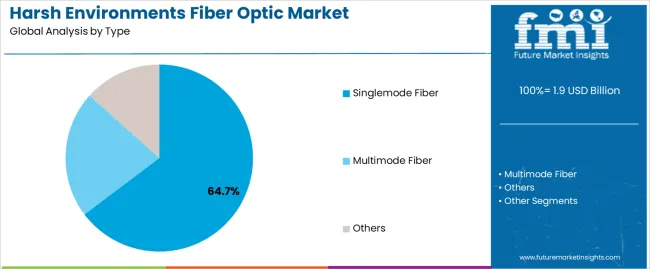
The singlemode fiber segment is projected to account for 64.7% of the harsh environments fiber optic market in 2025, reaffirming its position as the leading type category. Industrial operators and telecommunications integrators increasingly utilize singlemode fiber implementations for their superior data transmission performance when operating across diverse industrial platforms, excellent signal integrity properties, and widespread acceptance in applications ranging from oil and gas facilities to geothermal energy operations. Singlemode fiber technology's advanced transmission capabilities and proven reliability characteristics directly address the operator requirements for high-performance connectivity solutions in complex industrial environments.
This type segment forms the foundation of modern industrial communication adoption patterns, as it represents the implementation with the greatest transmission efficiency and established market demand across multiple industrial categories and operational segments. Operator investments in singlemode platform optimization and integration consistency continue to strengthen adoption among industrial producers and telecommunications suppliers. With industries prioritizing reliable data transmission and performance effectiveness, singlemode fiber implementations align with both functionality preferences and operational expectations, making them the central component of comprehensive industrial communication strategies.
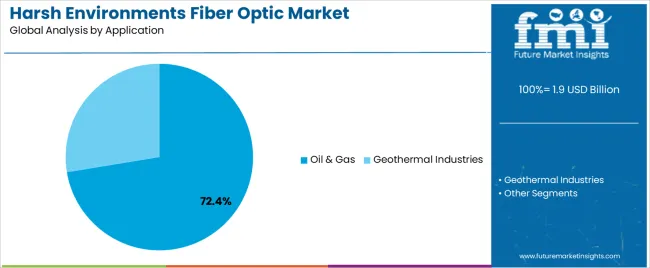
Oil & gas applications are projected to represent 72.4% of harsh environments fiber optic demand in 2025, underscoring their critical role as the primary deployment sector for optical systems across energy exploration, production operations, and upstream applications. Energy companies prefer harsh environment fiber optics for their exceptional environmental resistance characteristics, scalable deployment options, and ability to enhance operational connectivity while ensuring consistent communication performance throughout diverse energy platforms and operational processes. Positioned as essential communication components for modern energy operations, harsh environment fiber optic solutions offer both connectivity advantages and operational efficiency benefits.
The segment is supported by continuous innovation in energy sector communication technologies and the growing availability of specialized implementations that enable diverse operational requirements with enhanced performance uniformity and extended compatibility capabilities. Additionally, energy companies are investing in advanced systems to support large-scale operational integration and facility development. As remote monitoring technologies become more prevalent and communication requirements increase, Oil & Gas applications will continue to represent a major deployment market while supporting advanced energy utilization and technology integration strategies.
The harsh environments fiber optic market is advancing steadily due to increasing demand for resilient communication infrastructure and growing adoption of hardened optical systems that provide superior environmental protection characteristics and reliability benefits while enabling advanced industrial functionality across diverse energy and industrial applications. The market faces challenges, including complex environmental protection requirements, evolving industrial standards, and the need for specialized hardening expertise and compatibility programs. Innovation in environmental protection integration and advanced hardening systems continues to influence system development and market expansion patterns.
The growing adoption of industrial IoT, automated monitoring capabilities, and remote operation preferences is enabling system developers to produce advanced harsh environment fiber optic solutions with superior technology positioning, enhanced protection profiles, and seamless integration functionalities. Advanced optical systems provide improved connectivity while allowing more efficient deployment workflows and reliable performance across various industrial applications and operational conditions. Developers are increasingly recognizing the competitive advantages of remote monitoring integration capabilities for market differentiation and premium positioning.
Modern harsh environment fiber optic providers are incorporating advanced protection capabilities, enhanced hardening integration, and specialized environmental solutions to enhance system appeal, enable reliable industrial features, and deliver value-added solutions to industrial customers. These technologies improve operational reliability while enabling new market opportunities, including predictive maintenance, environmental monitoring, and enhanced safety characteristics. Advanced protection integration also allows developers to support comprehensive industrial communication systems and market expansion beyond traditional telecommunications approaches.
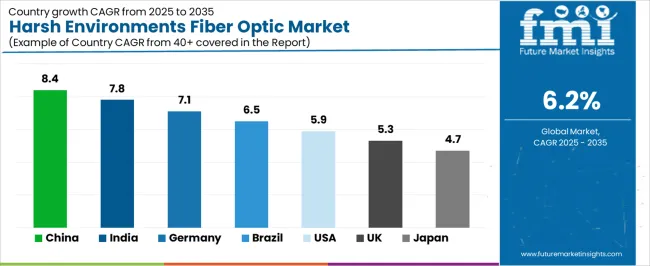
| Country | CAGR (2025-2035) |
|---|---|
| China | 8.4% |
| India | 7.8% |
| Germany | 7.1% |
| Brazil | 6.5% |
| United States (USA) | 5.9% |
| United Kingdom (UK) | 5.3% |
| Japan | 4.7% |
The harsh environments fiber optic market is experiencing steady growth globally, with China leading at a 8.4% CAGR through 2035, driven by expanding industrial automation adoption, growing energy sector modernization programs, and significant investment in infrastructure development. India follows at 7.8%, supported by increasing industrial manufacturing expansion, growing technology integration patterns, and expanding modern facility infrastructure. Germany shows growth at 7.1%, emphasizing industrial innovation leadership and premium technology development. Brazil records 6.5%, focusing on expanding energy sector capabilities and technology integration modernization. The USA demonstrates 5.9% growth, prioritizing advanced industrial technology development and remote monitoring adoption trends. The UK exhibits 5.3% growth, emphasizing industrial technology innovation and premium facility development. Japan shows 4.7% growth, supported by industrial excellence initiatives and technology-focused production patterns.
The report covers an in-depth analysis of 40+ countries, top-performing countries are highlighted below.
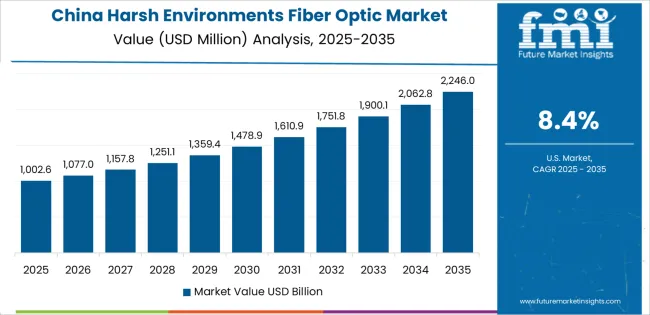
Revenue from harsh environments fiber optic in China is projected to exhibit strong growth with a CAGR of 8.4% through 2035, driven by expanding industrial automation adoption and rapidly growing energy sector technology integration supported by government initiatives promoting industrial modernization development. The country's strong position in industrial manufacturing and increasing investment in communication infrastructure are creating substantial demand for advanced fiber optic implementations. Major industrial operators and technology companies are establishing comprehensive deployment capabilities to serve both domestic facility development demand and expanding export markets.
Revenue from harsh environments fiber optic in India is expanding at a CAGR of 7.8%, supported by the country's growing energy sector, expanding industrial production capacity, and increasing adoption of advanced communication technologies. The country's initiatives promoting industrial modernization and growing technology awareness are driving requirements for hardened optical systems. International technology providers and domestic industrial companies are establishing extensive deployment and manufacturing capabilities to address the growing demand for resilient communication solutions.
Revenue from harsh environments fiber optic in Germany is expanding at a CAGR of 7.1%, supported by the country's industrial innovation heritage, strong emphasis on premium facility technology, and robust demand for advanced optical systems in industrial and energy applications. The nation's mature industrial sector and technology-focused operations are driving sophisticated fiber optic implementations throughout the industrial landscape. Leading operators and technology specialists are investing extensively in premium deployment and advanced integration technologies to serve both domestic and international markets.
Revenue from harsh environments fiber optic in Brazil is growing at a CAGR of 6.5%, driven by the country's expanding energy sector, growing technology integration programs, and increasing investment in industrial communication development. Brazil's large energy market and commitment to industrial advancement are supporting demand for diverse fiber optic solutions across multiple energy segments. Operators are establishing comprehensive deployment capabilities to serve the growing domestic market and expanding energy opportunities.
Revenue from harsh environments fiber optic in the USA is expanding at a CAGR of 5.9%, supported by the country's advanced industrial technology sector, strategic focus on communication solutions, and established energy sector capabilities. The USA's industrial innovation leadership and premium technology integration are driving demand for specialized fiber optic implementations in energy facilities, industrial operations, and premium applications. Operators are investing in comprehensive system development to serve both domestic specialty markets and international premium applications.
Revenue from harsh environments fiber optic in the UK is growing at a CAGR of 5.3%, driven by the country's focus on industrial technology advancement, emphasis on premium facility innovation, and strong position in energy sector development. The UK's established industrial innovation capabilities and commitment to technology diversification are supporting investment in specialized fiber optic technologies throughout major industrial regions. Industry leaders are establishing comprehensive technology integration systems to serve domestic premium facility operations and energy applications.
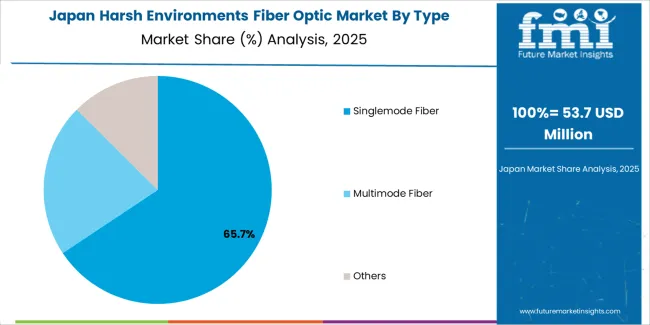
Revenue from harsh environments fiber optic in Japan is expanding at a CAGR of 4.7%, supported by the country's industrial excellence initiatives, growing premium technology sector, and strategic emphasis on advanced industrial development. Japan's advanced quality control capabilities and integrated industrial systems are driving demand for high-quality fiber optic platforms in premium facilities, advanced industrial, and technology applications. Leading operators are investing in specialized capabilities to serve the stringent requirements of technology-focused industrial and premium facility industries.
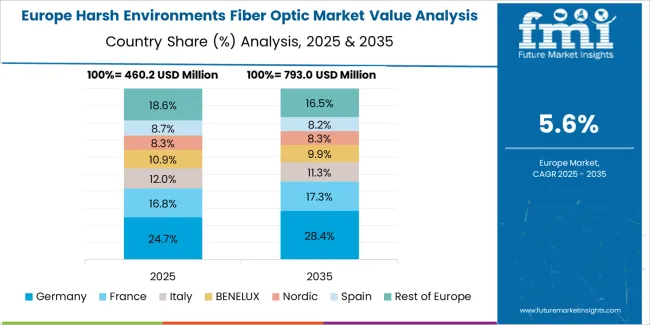
The harsh environments fiber optic market in Europe is projected to grow from USD 378.3 million in 2025 to USD 690.4 million by 2035, registering a CAGR of 6.2% over the forecast period. Germany is expected to maintain its leadership position with a 41.2% market share in 2025, declining slightly to 40.6% by 2035, supported by its strong industrial innovation culture, sophisticated facility manufacturing capabilities, and comprehensive industrial sector serving diverse harsh environment fiber optic applications across Europe.
France follows with a 19.7% share in 2025, projected to reach 20.4% by 2035, driven by robust demand for premium industrial technologies in energy applications, advanced manufacturing programs, and communication markets, combined with established industrial infrastructure and technology integration expertise. The United Kingdom holds a 13.8% share in 2025, expected to reach 14.2% by 2035, supported by strong industrial technology sector and growing premium facility activities. Italy commands a 11.5% share in 2025, projected to reach 12.1% by 2035, while Spain accounts for 8.4% in 2025, expected to reach 8.8% by 2035. The Netherlands maintains a 3.6% share in 2025, growing to 3.9% by 2035. The Rest of Europe region, including Nordic countries, Eastern Europe, Belgium, Poland, and other nations, is anticipated to maintain momentum, with its collective share moving from 1.8% to 0% by 2035, attributed to increasing industrial modernization in Eastern Europe and growing technology penetration in Nordic countries implementing advanced industrial programs.
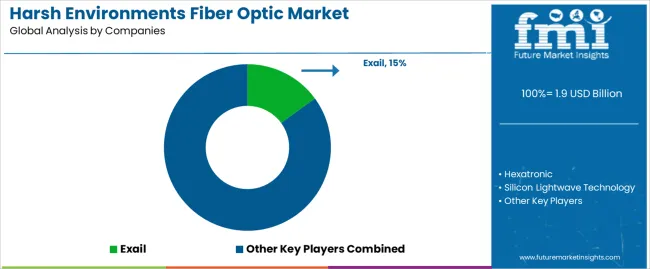
The harsh environments fiber optic market is characterized by competition among established telecommunications equipment companies, specialized optical system developers, and integrated technology solution providers. Companies are investing in environmental protection research, hardening optimization, advanced integration system development, and comprehensive optical portfolios to deliver consistent, high-quality, and application-specific harsh environment fiber optic solutions. Innovation in protection technology integration, reliability enhancement, and industrial compatibility improvement is central to strengthening market position and competitive advantage.
Exail leads the market with a strong market share, offering comprehensive optical system solutions including premium hardening platforms and advanced deployment systems with a focus on premium and industrial applications. Hexatronic provides specialized customization capabilities with an emphasis on advanced fiber implementations and innovative protection solutions. Silicon Lightwave Technology delivers comprehensive optical technology services with a focus on integrated platforms and large-scale industrial applications. Fujikura specializes in advanced optical components and specialized fiber implementations for premium applications. Corning focuses on industrial integration and innovative technology solutions. SEDI-ATI offers advanced optical platforms with emphasis on high-performance and reliability-critical applications.
| Item | Value |
|---|---|
| Quantitative Units | USD 1,891.5 million |
| Type | Singlemode Fiber; Multimode Fiber; Others |
| Application | Oil & Gas; Geothermal Industries |
| Environment Level | Extreme Temperature; High Pressure; Chemical Resistance; Radiation Protection |
| Installation Method | Buried Installation; Aerial Installation; Underwater Installation; Industrial Mounting |
| Temperature Range | High Temperature; Ultra High Temperature; Extreme Temperature |
| End-Use Sector | Energy Companies; Industrial Operators; Telecommunications Providers; System Integrators |
| Regions Covered | North America; Europe; East Asia; South Asia & Pacific; Latin America; Middle East & Africa |
| Countries Covered | China; India; Germany; Brazil; United States; United Kingdom; Japan; and 40+ additional countries |
| Key Companies Profiled | Exail; Hexatronic; Silicon Lightwave Technology; Fujikura; Corning; SEDI-ATI |
| Additional Attributes | Dollar sales by type and application category; regional demand trends; competitive landscape; technological advancements in environmental protection integration; premium hardening development; reliability innovation; industrial integration protocols |
The global harsh environments fiber optic market is estimated to be valued at USD 1.9 billion in 2025.
The market size for the harsh environments fiber optic market is projected to reach USD 3.5 billion by 2035.
The harsh environments fiber optic market is expected to grow at a 6.2% CAGR between 2025 and 2035.
The key product types in harsh environments fiber optic market are singlemode fiber, multimode fiber and others.
In terms of application, oil & gas segment to command 72.4% share in the harsh environments fiber optic market in 2025.






Full Research Suite comprises of:
Market outlook & trends analysis
Interviews & case studies
Strategic recommendations
Vendor profiles & capabilities analysis
5-year forecasts
8 regions and 60+ country-level data splits
Market segment data splits
12 months of continuous data updates
DELIVERED AS:
PDF EXCEL ONLINE
Noise Vibration Harshness (NVH) Testing Market
Server Operating Environments Market
Optical Spectrum Analyzer Market Size and Share Forecast Outlook 2025 to 2035
Optical Extinction Analyzer Market Size and Share Forecast Outlook 2025 to 2035
Optical Character Recognition Market Forecast and Outlook 2025 to 2035
Optical Satellite Market Size and Share Forecast Outlook 2025 to 2035
Optical Imaging Market Size and Share Forecast Outlook 2025 to 2035
Optical Whitening Agents Market Size and Share Forecast Outlook 2025 to 2035
Optical Fingerprint Collector Market Size and Share Forecast Outlook 2025 to 2035
Optical Lens Materials Market Size and Share Forecast Outlook 2025 to 2035
Optical Microscope Market Size and Share Forecast Outlook 2025 to 2035
Optical Component Tester Market Size and Share Forecast Outlook 2025 to 2035
Optical EMI Shielding Adapters Market Size and Share Forecast Outlook 2025 to 2035
Optical Connector Polishing Films Market Size and Share Forecast Outlook 2025 to 2035
Optical Transmitter Market Size and Share Forecast Outlook 2025 to 2035
Optical Telephoto Lens Market Size and Share Forecast Outlook 2025 to 2035
Optical Lattice Clock Market Size and Share Forecast Outlook 2025 to 2035
Optical Grade Lithium Tantalate Wafers Market Size and Share Forecast Outlook 2025 to 2035
Optical Grade LiTaO3 Crystal Substrate Market Size and Share Forecast Outlook 2025 to 2035
Optical Brighteners Market Size and Share Forecast Outlook 2025 to 2035

Thank you!
You will receive an email from our Business Development Manager. Please be sure to check your SPAM/JUNK folder too.
Chat With
MaRIA